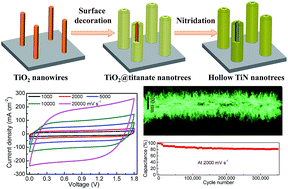Hollow TiN nanotrees derived from a surface-induced Kirkendall effect and their application in high-power supercapacitors†
Abstract
Electrode materials with hollow micro/nanostructures and high electrical conductivity are important for achieving high-power supercapacitors, especially those with super-fast charging/discharging. TiN, which can be easily obtained from TiO2, is regarded as a high-power supercapacitor material. Here, we report that a nanoscale Kirkendall effect is triggered by surface branches on TiO2 nanowires, which then transform into hollow TiN nanotrees during a thermal nitridation process. The surface branches play a key role in accelerating the initial reaction, which forms a uniform, continuous surface TiN layer and induces the Kirkendall effect via surface diffusion. The hollow TiN nanotrees have a high surface area, porous structure, and high electrical conductivity. The constructed symmetric supercapacitors exhibit high areal and volumetric energy density, super-fast charge/discharge ability, and good capacitance retention up to 350 000 cycles. This work provides a new method to synthesize hollow TiN nanostructures and demonstrates their advantages in achieving high-power energy storage devices.



 Please wait while we load your content...
Please wait while we load your content...